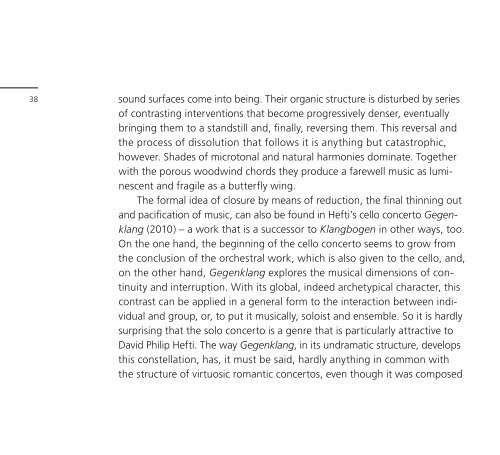David Philip Hefti Changements - Col Legno
David Philip Hefti Changements - Col Legno
David Philip Hefti Changements - Col Legno
Erfolgreiche ePaper selbst erstellen
Machen Sie aus Ihren PDF Publikationen ein blätterbares Flipbook mit unserer einzigartigen Google optimierten e-Paper Software.
38 sound surfaces come into being. Their organic structure is disturbed by seriesof contrasting interventions that become progressively denser, eventuallybringing them to a standstill and, finally, reversing them. This reversal andthe process of dissolution that follows it is anything but catastrophic,however. Shades of microtonal and natural harmonies dominate. Togetherwith the porous woodwind chords they produce a farewell music as luminescentand fragile as a butterfly wing.The formal idea of closure by means of reduction, the final thinning outand pacification of music, can also be found in <strong>Hefti</strong>’s cello concerto Gegenklang(2010) – a work that is a successor to Klangbogen in other ways, too.On the one hand, the beginning of the cello concerto seems to grow fromthe conclusion of the orchestral work, which is also given to the cello, and,on the other hand, Gegenklang explores the musical dimensions of continuityand interruption. With its global, indeed archetypical character, thiscontrast can be applied in a general form to the interaction between individualand group, or, to put it musically, soloist and ensemble. So it is hardlysurprising that the solo concerto is a genre that is particularly attractive to<strong>David</strong> <strong>Philip</strong> <strong>Hefti</strong>. The way Gegenklang, in its undramatic structure, developsthis constellation, has, it must be said, hardly anything in common withthe structure of virtuosic romantic concertos, even though it was composedfor a virtuoso, Thomas Grossenbacher, to whom it is also dedicated. In thiswork, the motions of struggle and triumph (which have in any case becomeworn) are replaced by a perpetual threading into a discrete and yet differentiatedorchestral sound that hardly ever appears as an antagonist to the soloinstrument, rather as its veil or as its shadow. For long stretches of the firstmovement the music creates an underground or a background, into whichthe expansive rhapsodic cello melody delves, and from which it emerges againand again. The conception of the movement follows the idea of a steadilyincreasing motion, in a general formal sense as a composed accelerando, andalso on a more detailed level by virtue of the micro-counterpoint enlivenmentof supposedly static sound surfaces. The climax of this intensification isreached at the end of the movement, before the horns throw out a singletone from the orchestra’s quadruple forte, building a bridge to the secondmovement. Here, as in the final section of Klangbogen, fragile sounds ofuntempered overtones and microtonal harmonies dominate, before the movementloses itself in the soloist’s endless final tone. In a dramaturgic sense,this is all as clever as it is compelling, not only the soundscape but also theformal idea displays an affinity with works of György Ligeti that cannot bedenied. This is neither surprising nor is it an insult. It was, after all, Ligeti’s celloconcerto that (re)opened this genre to specifically contemporary composition.39


